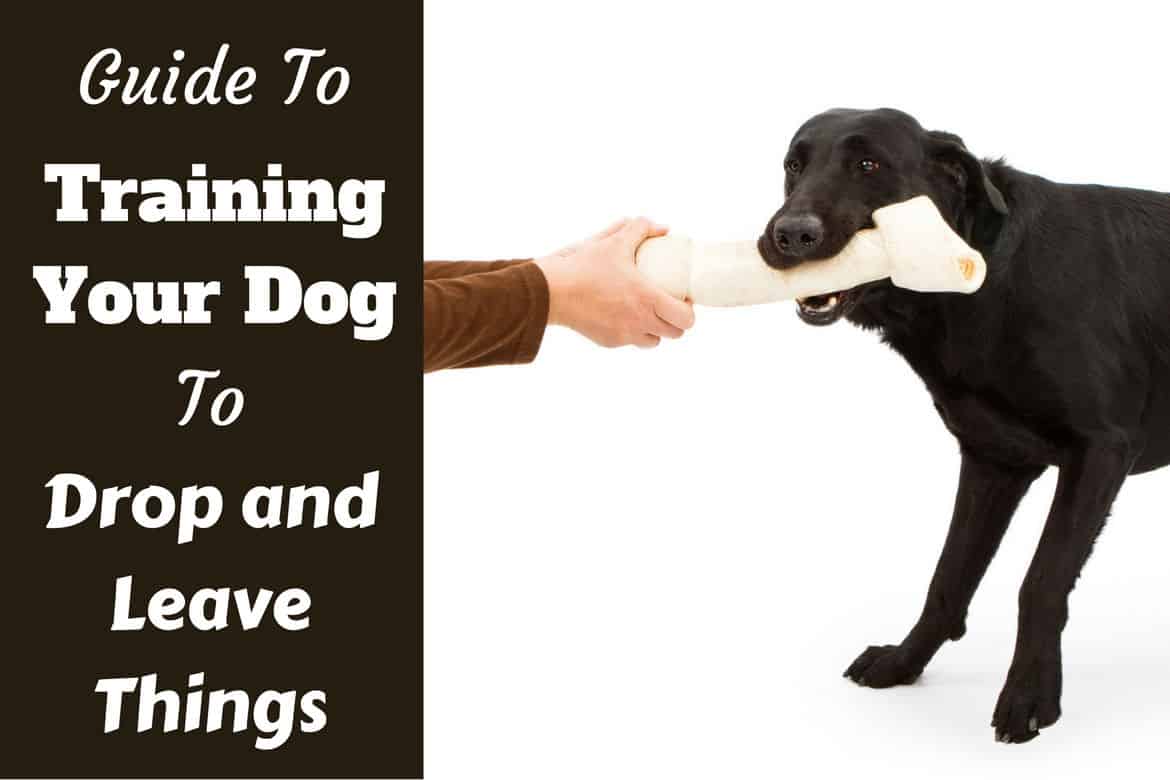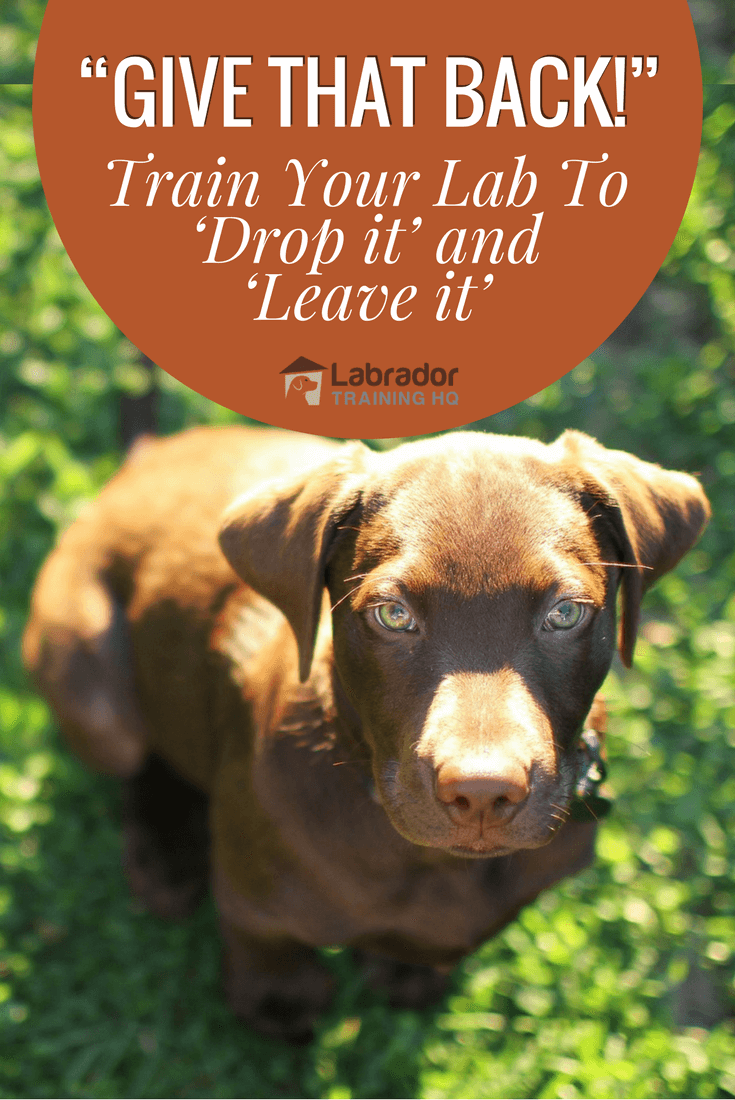This post may contain affiliate links. We may earn money or products from the companies mentioned in this post.

It’s easy to forget that dogs aren’t people. After all, they seem to understand our thoughts and feelings and we’ve all borne witness to that wise and knowing look they have in their eyes.
However, dogs do think and behave differently from us and you need look no further than their mouth for evidence of this fact.
Anyone who’s lived with a Lab will have received “presents” they don’t want and if you’re unlucky enough, you might have had to chase a prized belonging around your home with your dog refusing to drop it!
However, your Lab can’t be allowed to put just anything in their mouth, this is dangerous, but getting a dog to give up something they want to hang on to is no small feat.
You’ll reduce your stress—and the time you spend fishing around for things in your dog’s mouth—if you can teach them to leave objects alone in the first place. In fact, once your dog has mastered it, the “leave it” command may very well be your favorite trick.
No dog is perfect, of course, and you can’t watch yours every second of every day, so you will also have to train your lab to “drop it.”
Doing so may mean you never have to fish your slippers, TV remote or decaying piece of garbage from between your four-legged friends jaws again.
Before We Start: What Not to Do
Before you begin teaching your dog to drop and leave things, you need to disabuse yourself of any outdated training notions you might have heard. Therefore, I’m going to say here a few words about domination and punishment.
Why bring this up now? Because when a dog has something in their mouth they just won’t give up, this is the situation in which I’ve seen the most owners get heated and angry. Through frustration they raise their voices, maybe even get physical, all in an attempt to wrench a valuable item free from the jaws of their dog.
So first and foremost, please forget the idea that dogs respond to being dominated or punished. They do not.
In the wild, alpha dogs are neither aggressive nor violent, and behaving in such a way is more likely to get them kicked out of the pack than promoted to a leader to be followed.
Punishing, yelling at, or hitting your dog only causes them to lose respect for you. It’s also totally ineffective because even if they drop the item this time, they haven’t actually learnt anything. Except maybe you’re irrational and unreasonable.
How To Teach A Dog to Drop It
If you’ve spent years trying to wrestle foreign objects from your pooch’s clutches, it’s going to come as a pleasant surprise to learn just how easy it is to train a dog to drop things.
And the more frequently you practice, the more quickly and effectively your dog will master the command. To begin the process, follow these simple steps:
- Give your dog a toy they like, but not one they love. A much-beloved toy can be too hard to give up this early in the training process. After your dog has the toy in their mouth, give the ‘drop’ command while showing them a tasty treat they love.
- As soon as your dog drops the object – and they will to take the treat – click (or mark) for the behavior and give them the treat. (Click here to learn how and why to use a clicker) Repeat this exercise at least five times the first time you do it, and a couple of times each day thereafter.
- After practicing for about a week, it’s time to up the ante. Instead of one they just like, give your dog an object they truly love – a favorite bone or their best indestructible chew toy, for example. Repeat the same procedure, exchanging the item for a treat. Continue repeating this exercise a couple of times a day for at least a week. If they fail to drop their item, go back to practicing with something less valuable before upping the ante again.
- Now it’s time to stop giving a treat every time your dog follows through. Begin giving a treat every two to three times so that your dog never knows if they’re going to get a treat. This approach, called ‘intermittent reinforcement‘, is the most effective way to encourage a dog to do something on a long-term basis.
- Continue repeating the exercise with progressively more challenging toys and treats. And use every time your dog has something in their mouth as an opportunity to practice by asking them to “drop it” and praising enthusiastically when they do. The more often you practice, the better your dog will get at following the command.
Training The ‘Leave It’ Command
Ignoring a tempting morsel of food or a squealing animal in the yard is no small feat for even the most disciplined of dogs. However, training your dog to “leave it” will help them master impulse control while ensuring you don’t have to worry so much about what’s in their mouth.
Use the same reward-based approach to teach the “leave it” command as you used to help them master “drop it” by following these simple steps:
- Have your Lab on leash so they are under your control and cannot get at the object you’re going to ask them to leave. It’s important they cannot get the object.
- Put something your dog feels relatively neutral about—such as a toy they never much cared for—on the floor in front of them, then tell them to “leave it.” When they ignore the object, click the training clicker and give them a treat. Only click and treat when they remove their attention from the object. Repeat this four to five times.
- Next, put something your dog likes, but does not love, in front of them and again tell them to “leave it.” If they try to take the object, ignore this fact, take the object away and put it back until they successfully ignore it. If they do leave it, click the training clicker and give them a treat. Again, you are looking for them to remove their attention from the object, to look away from it toward you or anywhere else before you click and treat.
- Don’t be put off if they sometimes try to take the object which is sure to happen. The contrast of telling them “wrong” and taking it away, to them leaving it and earning praise and a treat is all a part of the learning process. Just make sure they are under control on a leash and do not get to the object.
- Repeat this trial until they are reliably ignoring the favored object. Continue practicing with more and more challenging objects on a nightly basis until your dog reliably obeys the command, the most difficult of objects usually being a high value food treat.
- Finally, move your training outside where you can begin teaching your dog to ignore squirrels, people, other dogs, and similarly tempting items. Using the same protocols you’ve already mastered, tell your dog to leave it when you see a tempting object, then click and reward them when they obey.
Extra Tips For Training A Dog To “Drop It” And “Leave It”
- Consistency is the key to a perfectly trained dog. Use the same word for the same command every time, and only say the command once. Saying: “Fido, drop it. No, Drop it. Drop that. Drop that now!” convinces your dog that the full sentence is the command, confusing them beyond belief. It also teaches them they can ignore the command.
- You will need to periodically reward your dog for good behavior for the rest of their life. After they master ‘Drop it’ and ‘Leave it’, occasionally do a practice round so they can be rewarded, thereby encouraging them to continue following your cues.
- Ensure you use different sounding commands for different behaviors. It doesn’t matter whether you use “give”, “drop it”, or some other variation. Drop and stop, though, are too similar, so steer clear of rhyming words or commands for different things that will be challenging for your dog to distinguish from one another.
- Finally, when dogs disobey, they’re not doing so to be manipulative. They simply don’t have the capacity for such behavior. Instead, disobedience is because your dog is distracted, poorly trained or doesn’t yet understand the command and is simply confused. So if your dog doesn’t drop or leave on cue, dedicate more time to this training…and be patient and understanding!
Conclusion
Teaching your dog to ‘drop it’ and ‘leave it’ is of great benefit to you both. You will enjoy far fewer chewed or ‘dog-slobbered’ possessions, and you can keep your dog safer by preventing them chewing on and possibly swallowing dangerous things.
The amount of time it takes to master these commands depends on your dog’s age, intelligence, willingness to please, and your skill and dedication as a trainer. However, you can generally expect mastery within just a few short weeks.
Keep trying. After all, practice makes perfect, for dogs and humans alike!
Save to Pinterest

Top Picks For Our Dogs
- BEST PUPPY TOY
We Like: Calmeroos Puppy Toy w/ Heartbeat and Heat Packs - Perfect for new puppies. Helps ease anxiety in their new home. - BEST DOG CHEW
We Like: Bones & Chews Bully Sticks - All of our puppies love to bite, nip, and chew. We love using Bully Sticks to help divert these unwanted behaviors. - BEST DOG TREATS
We Like: Crazy Dog Train Me Treats - One of our favorite treats for training our service dog puppies. - BEST FRESH DOG FOOD
We Like: The Farmer's Dog - A couple months ago we started feeding Raven fresh dog food and she loves it! Get 50% off your first order of The Farmer's Dog.
For a list of all the supplies we get for our new service dog puppies check out our New Puppy Checklist on the PuppyInTraining.com blog.

3 comments
My dog learned ‘leave it’ really quickly. She’ll pretty much stop what she’s doing immediately and look at me or come to me after I tell her to leave something alone. However after she leaves it and realises that no treat or no more treats (if I’ve rewarded the behaviour) is coming her way, then she just goes back to trying to do what she was doing before like grabbing a slipper or poking around in the coal bucket.
Any help with how to solve this?
Thanks for sharing such great information. This is really help to me.
I followed your blog. So please share these types of information in future.
My dog has learned that if he wants a treat all he has to do is grab something he knows he shouldn’t have then I’ll make him drop it and give him a treat. He knows leave it but if I don’t see him grab the item it’s too late for leave it.